Leonard Brillson
Editor, INTERSECTIONS
Member, Government Affairs Committee
Welcome to our INTERSECTIONS Newsletter!
Since our last newsletter, the agreement between Congress and the White House to suspend the Federal debt limit for the next two years has allowed Congress to begin work on appropriations legislation that would provide continued Federal support for our science and technology. The MRS Government Affairs Committee (GAC) aims to understand the associated changes in legislative policy environment and its impact on materials research.
GAC Chair David Norton recounts why this is an exciting time for materials research and how the MRS GAC aims to play a proactive role in supporting materials research investments.
Our MRS Washington DC consultant Damon Dozier describes how Congress and the Administration have begun to apportion the Federal budget among the various Appropriations bills that include the agencies that fund materials research.
Our Grassroots Subcommittee Chair Boris Dyatkin describes how our Grassroots Subcommittee connects our materials scientist community with important Federal policy changes and agency operations.
Jennifer Nekuda Malik, Chair of the Advocacy Engagement Subcommittee, describes developing materials success stories to help educate Congresswomen/men about the impacts of science funding on their own constituents.
Our Congressional Fellowship Program Chair Ashley White describes activities of our current Fellows on Capitol Hill, how alumni Fellows continue to have an impact within the program, and how to learn more about the 2020–2021 MRS Congressional Fellows program.
Bill Hammetter, our Congressional Visits Day Subcommittee Chair, describes the many ways MRS interacts with legislators to support continued and indeed increased funding for fundamental scientific research.
Government Agency Subcommittee Chair Diogenes Placencia describes the success of this year’s highly attended International Materials Research Congress (IMRC 2019) in Cancun, Mexico and the various agency representatives describing funding opportunities.
Finally, Nancy Sottos’ INTERSECTIONS article on value-added materials science in this Issue features yet another success story, highlighting how Federal investments in materials science pay off in ways that the public and especially our elected officials can relate too.
MRS is working hard to make sure that the materials research community is being heard and that it has input in developing effective government policy for support of materials science. Here is the latest news….
Government Affairs Committee Chair—
Materials Research for the Innovations of Tomorrow
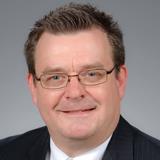 David Norton
David Norton
Chair, Government Affairs Committee
This is an exciting time to be working in the area of materials science. Whether it is 3-D printing of biomaterials, discovery of new correlated electronic phenomena or predictive studies using machine learning, the materials research of today is laying the foundation for innovations and technologies for the next decades. In the coming months, the focus of the MRS Government Affairs Committee will be on efforts in Washington, DC to advance our materials research agenda to the US Congress, Federal agencies and the Administration. In a town where the attention span on a given topic rarely exceeds 30 days, it is challenging to secure support for materials research investments whose payoff might not be realized for 30 years. Nevertheless, one of the core objectives of the MRS Government Affairs Committee is to be a forward-leaning voice in Washington, DC in representing the materials research community and communicating its importance.
As we move into 2020 and realize that some of our most exciting materials research might not realize technologies and innovations until 2050 or beyond, it is instructive to look back 30 years and remember what now commonplace innovations and technologies simply did not exist at that time. In 1990, there was no Amazon, no Google, no online purchasing, no email, not even AOL, because there was no worldwide web. Optic fiber technology was just beginning to impose its will in revolutionizing data transmission. Movies were not something streamed, nor were DVDs available for purchase. Instead, you rented movies from the local video store on VHS tape cassettes. Portable music was dominated by a technology known as the Walkman and played on cassette tapes. The MP3 players and USB thumb drives that we take for granted today were simply nonexistent as solid-state memory and associated materials were just emerging as players in this realm. Wireless communication was in its infancy as there were no digital cellphones, only clunky analog handsets. It is hard to imagine that just 30 years back, emailing on a Blackberry was yet to emerge as the hottest technology in business. Even the Palm Pilot Personal Digital Assistant was not available to manage calendars and appointments. Advances in signal transmission, receiving, computation, and energy storage, all technologies dependent on materials developments, would usher in the smartphone revolution that we now see worldwide. All of these technologies penetrated our consciousness after we opened the 1990’s some 30 years back.
Today, our conversations with Congress center on research opportunities in quantum science, topological insulators, artificial intelligence, and synthetic biology along with the promise each presents. These and other topics of interest and importance to the materials research community present significant potential to reset technologies in the coming decades. Some of the impactful advances are predictable. Others will surprise us. All will be dependent on a foundation of materials research in order to lead. Whether for technologies in communication, computing, sensors, transportation, energy, or medicine, the materials research we do today is critical to the future of our planet and its economies, and support from government agencies is vital to our success.
What's Happening in Washington
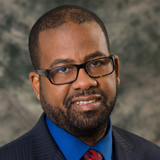 Damon Dozier
Damon Dozier
MRS Director of Government Affairs
Right before the summer recess, the White House and Congress came to terms on an agreement to raise caps on discretionary spending and suspend the Federal debt ceiling for the next two fiscal years. With this agreement, Congress can now move forward on Federal agency funding, with the hope that the work can be completed in the upcoming months. As Congress, sets spending levels for the final two years covered by the Budget Control Act of 2011, the deal also ended the use of statutory spending caps and automatic budget sequestration as checks on the appropriations process. The bulk of the increases contained in the agreement would come in fiscal year 2020, with the cap on non-defense spending rising 4% to $622 billion and the cap on defense spending rising 3% to $677 billion. For the following fiscal year, the cap for each category would increase about 1%. Most science agencies are funded out of the non-defense portion of the budget.
These increases are not as large as those provided through the last budget agreement, reached in 2017, which raised the cap on non-defense spending by 12% for fiscal year 2018 and 3% the following year. Despite this agreement, Congress and the Administration still must agree on how to apportion the budget among the 12 annual appropriations bills that fund the Federal government. The House already approved most of its bills (10 of 13) earlier this year, with assumption that non-defense spending would increase 6%. Meanwhile, the Senate opted to wait until a budget agreement was reached before advancing its own proposals – as of the deadline date for this article, none of the 13 bills have been introduced, much less considered by their respective committees. Senate staff, however, are starting to construct original language for its appropriations, but as indicated, do not know the subcommittee allocations as of yet. Although House appropriators will likely have to rein in at least some of their proposed increases for science programs, their finished bills represent a starting point for negotiations with the Senate.
Recently reported was the Senate Republicans are looking to divert health, education funds for border security efforts.
According to meetings that MRS has had with Congressional staff, the Senate may mark-up Appropriations bills for Health & Human Services, Military Construction and Energy & Water the first week of September, with full Committee consideration to happen the next week, and floor consideration the next. At this point, it is not certain that Congress will meet the deadline of September 30, for passage of all bill, so we may see a Continuing Resolution (CR) for a few weeks or months. This may come in the form of a minibus (more than one bill at a time); cromnibus (combination of long-term spending bill and a shorter-term CR); or an Omnibus, all bills wrapped together. If the case of a CR, if it lasts more than a few weeks, Federal agencies are reluctant to make new grant awards, conduct peer review panels or start new initiatives. If CR is shorter, operations should continue normally.
The Senate confirmed earlier this year Chris Fall to be Director of the Department of Energy’s Office of Science. Fall, who holds a doctorate in neuroscience, previously served for a short period as the Trump administration’s top official at the Advanced Research Projects Agency–Energy. Before that, he held a series of positions with the Office of Naval Research, including acting chief scientist, and from 2014 to 2017, he was detailed to the White House Office of Science and Technology Policy as its assistant director for defense programs and later as acting head of its national security and international affairs division. The Office of Science, which administers a $6.6 billion portfolio of fundamental research, had been without a director for the duration of the Trump administration. During that time, the top civil servant in the office, Steve Binkley, had been standing in as director.
The Senate also confirmed Lane Genatowski to be the Director of Advanced Research Projects Agency–Energy. Genatowski brings a background in energy sector finance to the position and holds degrees in economics and law. At his confirmation hearing, he said he sincerely wishes to lead ARPA–E despite the Trump administration’s continued efforts to defund the agency, which currently has a $366 million budget.
Grassroots Subcommittee Chair News—
Connecting Our Materials Science Community with Government Science Policy
 Boris Dyatkin
Boris Dyatkin
Chair, Grassroots Subcommittee
The Grassroots Subcommittee continued and expanded on its advocacy and engagement mission on behalf of thousands of American materials scientists. Over the past year, our committee grew and welcomed into its rank three researchers from academia, industry, and government laboratories. These valuable reinforcements to our mission bring fresh perspective and firsthand knowledge on the impact that science policy has on the state of research in the United States.
As we step into the fall season and keep a close (and anxious) eye on the flurry of legislative activity that directly impacts the operating budgets of key scientific agencies, we remind the MRS community of its crucial role in staying engaged and informed. The tireless advocacy work of the MRS Government Affairs Committee is only as strong as the scientific community whom it represents. You, as our constituents, have a vital role in this process. The Grassroots Subcommittee provides each of you with a direct link to the decision makers in Washington with our Materials Voice campaign. This opportunity will be available to you at the upcoming 2019 MRS Fall Meeting in Boston. The lawmakers will only act on pragmatic scientific legislation if they hear from all of you – advocacy does not get any clearer or simpler than that!
When you hear the phrase “government science policy,” what is the first action item that comes to mind? The Grassroots Subcommittee connects our materials scientist community with the important policy changes and agency operations that directly influence our work. The scope of these policies goes far beyond budget funding levels. Many legislative authorization bills reflect our national priorities, including quantum research and artificial intelligence. These initiatives set the research priorities for programs that will receive the most attention and resources in the coming years, and the MRS community must adapt accordingly. Grant proposals, technology development, and teaching curricula must reflect this evolving landscape. Ask yourself and your colleagues: Are you informed and prepared?
Advocacy Engagement—
Fall 2019
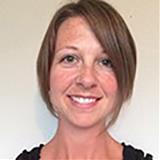 Jennifer Nekuda Malik
Jennifer Nekuda Malik
Chair, Advocacy Engagement Subcommittee
Materials success stories have been the primary focus of the Advocacy Engagement Subcommittee for the last few months. The subcommittee initially turned four materials success stories into memos distributed on Capitol Hill during the Spring Congressional Visits Days (CVD). The stories covered a range of materials-related topics including LED lighting for increased energy efficiency, power electronics enabled by advances in materials science, diamond-like carbon coatings to enhance performance and durability of a range of manufactured parts, and the benefits and emerging applications of additive manufacturing (3D printing). The purpose of these stories is to help provide context on some of the reasons the MRS advocates for strong science budgets and to give Congressional offices another resource when they are considering legislation that affect science. The long-term goal of this project is to generate a number of these success stories from around the country to help educate Congress people about the impacts of science funding on their own constituents and from within their own states or districts. The initial stories received well on Capitol Hill, and both Congressional staffers and CVD participants suggested enhancing the stories with related graphics to produce a more finished product.
Following the Spring CVD, the AE subcommittee generated a fifth success story on the myriad potential applications for two-dimensional materials, and identified images to accompany each of the five initial stories. Once the stories and graphics were ready, the subcommittee consulted the MRS marketing, communications, and graphics team to discuss making these success stories into impactful handouts for distribution on Capitol Hill. The graphics team is currently working on the first story to generate a template, once approved it will be used to finalize the first five stories for distribution during the 2020 Spring CVD.
In addition to the work on the success stories, the AE subcommittee has also consulted with the MRS marketing, communications, and graphics team to identify a strategy for updating the MRS government affairs website. The update will include a refresh of the advocacy narrative to better highlight the importance of advocacy, provide resources and context on MRS advocacy issues, and inform members of different ways to become involved. In conjunction with revamping the messaging, we are reorganizing the current website with new content that better illustrates some of the MRS advocacy work; and social media will help drive traffic to the advocacy page and better inform Members of the GAC's work.
Finally, a new class of Congressional Fellows is gearing up to start their fellowship year. The AE Subcommittee oversees these fellowships, and for more information on this topic see the Fellowship Chair Ashley White's article.
MRS Congressional Science & Engineering Fellowship Corner—
The Newest Congressional Science and Engineering Fellows Have Arrived in Washington, DC!
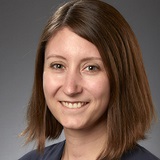 Ashley A. White
Ashley A. White
Chair, Congressional Fellowship Program
At the beginning of September, 2019–2020 Congressional Fellows Danny Broberg [MRS/The Optical Society (OSA)] and Alex Martin [MRS/The Minerals, Metals and Materials Society (TMS)], joined a handful of former MRS Fellows for the annual kickoff breakfast in Washington, DC. In addition, four former MRS Fellows based in the San Francisco Bay Area convened for a send-off event earlier this summer for Danny, who just finished his Ph.D. at UC Berkeley.
These gatherings have become a tradition, allowing incoming fellows to receive valuable advice from former fellows, and strengthening connections among the growing body of more than 30 MRS fellowship alumni spanning the now 25 years of the fellowship program. The alumni network boasts leaders in positions across the spectrum including academia, industry, startups, government and policy, as well as a number who have remained on the Hill in various capacities.
Danny and Alex are now wrapping up a two-week-long science policy orientation program organized by the American Association for the Advancement of Science (AAAS) to introduce the policy and political landscape before they begin interviewing with Congressional offices to find their placement for the duration of their fellowship year. Look for an update in a future issue of INTERSECTIONS for information on their placement offices and policy issue areas.
Our 2018–2019 MRS Congressional Fellows, Dylan Rittman (MRS/OSA) and Michele Bustamante (MRS/TMS) have completed their fellowship year, working in the offices of Senator Kirsten Gillibrand (D-NY) and Senator Ed Markey (D-MA), respectively.
During his fellowship year, Dylan worked on a wide variety of issues, including defense, foreign policy, technology, and manufacturing. He passed an amendment to the annual defense authorization bill that put in place reforms to the Manufacturing USA program recommended by the National Academy of Sciences. Going forward, Dylan will be working in the tech industry in the Bay Area.
The high hopes Michele held for the experience were far exceeded when she got to contribute to the Green New Deal Resolution (S.Res.59), helping advance the Congressional conversation on climate change. She also had the chance to serve as a regular bridge between the scientific community and policymakers by leading the organization of weekly expert briefings for senators of the Climate Change Task Force. As she pursues her next opportunity working in the climate policy space, she leaves the fellowship experience feeling more empowered to use her voice as a citizen and more hopeful for change knowing there are so many incredibly intelligent and passionate staff working behind the scenes.
Applications for the 2020–2021 MRS Congressional Fellowship are due January 3, 2020. If you are interested in learning more about the program and will be at the 2019 MRS Fall Meeting in Boston, I encourage you to come to our information session on Tuesday, December 3 from 4:15–5:15 pm.
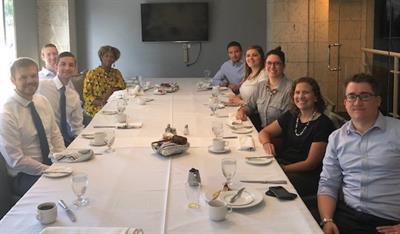
From left:
Danny Broberg (incoming fellow), Alex Martin (incoming fellow), Scott Litzelman (2017-2018), Ticora Jones (2008-2009), Drew Steigerwald (2012-2013), Mirvat Abdelhaq (2012-2013), Michele Bustamante (2018-2019), Laura Povlich (2011-2012), Peter Winter (2015-2016).
Fall Congressional Visits Day
 William (Bill) Hammetter
William (Bill) Hammetter
Chair, Congressional Visits Day Subcommittee
One goal of your MRS Government Affairs Committee is to make our legislators, U.S. Senators and members of the U.S. House of Representatives aware of the importance of continued (hopefully enhanced) funding for fundamental scientific research. Other important issues that are of concern to the MRS are continued collaborations with non-US citizens, visa issues, and of course, taxing graduate student tuition/fee reimbursements. With many years of experience, our society has learned that an effective way of delivering our “message(s)” to US legislators is to have MRS members visit their Senators and Representatives in Washington, D.C., or in their home districts, delivering a somewhat structured, consistent message on specific, timely topics. On September 10-11, 2019, some members of the MRS Presidential Line and a few members of the Board of Directors traveled to our Nation’s Capital to meet with key Senators and House members delivering a request for specific dollar amounts for the budgets of DOE Office of Science, NSF, select NIH Biomaterials initiatives, NIST, and DoD Basic Research funding. The targeted legislators, selected for their membership on key appropriations and authorization committees, were Senators Schumer (NY), Cruz (TX), Rubio (FL), Heinrich (NM), and House Members Lamb (PA) and Frankel (FL).
The delegation also met with Dr. Bindu Nair, Deputy Director of DoD’s Basic Research Office: Dr. Steve Brinkley, Deputy Director DOE Office of Science; Mr. Lane Genatowski, Director DOE ARPA-E; and Dr. Kelvin Droegemeier’s staff at OSTP to discuss current and upcoming science initiatives like Quantum Materials, Artificial Intelligence, and continued support of STEM education.
MRS participants in the Fall Congressional Visits Day were Matt Copel, MRS Vice President, Monica Jung de Andrade, MRS Board Member, David Norton, MRS Government Affairs Committee Chair, Todd Osman, MRS Executive Director, and Damon Dozier, MRS Director of Government Engagement.
National and International Materials Research Meetings
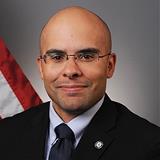
Diogenes (Dio) Placencia
Chair, Government Agency Subcommittee
Dear Members:
The Government Agency Subcommittee hopes all of you and your families have enjoyed the summer (for those of you in the Northern Hemispheres) fully. As you are all well aware (hopefully!), our Subcommittee seeks to connect you with research funding agencies to further your life’s work, whether at an academic, industrial, or government institution. With the recent SMM/MRS joint Meeting concluding (International Materials Research Congress – IMRC - third week of August in Cancun, Mexico), it is worth taking stock of the success that the Subcommittee has had with the Research Funding Opportunities session at this conference.
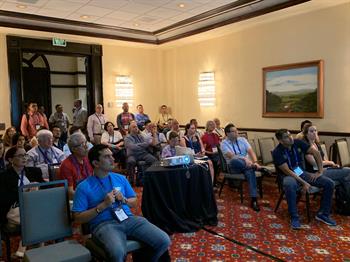
Funding Opportunities session at IMRC in Cancun, Mexico
|
This year, the session was highly attended by many members (for the conference, there were 1,647 attendees from 41 countries). Representatives from the National Science Foundation’s International Science Office (NSF-OISE), the UC-Mexico Initiative, Office of Naval Research Global (ONRG), U.S. Air Force’s Southern Office of Aerospace Research & Development (SOARD), and the U.S. Army’s Combat Capabilities Development Command (CCDC-Americas) all presented on funding opportunities for researchers throughout Latin America. Compared to last year, which was its first year, attendance was higher with a significantly higher level of engagement from the participating members, and overall positive feedback. Although smaller, this conference serves as a small litmus test for the idea that the membership continues to show interest in our service to the Society.
Therefore, as we prepare for our Fall Meeting in Boston, we continue to improve further upon our Research Funding Opportunities sessions, aided by each additional meeting in the calendar year (currently three in total). As always, we depend on you for feedback about what works, and what does not, which arguably is more important than the former…because at the end of the day, this service is here for you, the Member. Until next time.
A Value-Added Materials Research Story—
Self-healing Research Harnessed for Diverse Applications
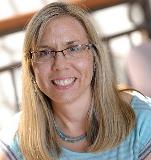
Nancy Sottos
Co-founder of Autonomic Materials Inc.
Swanlund Chair, Department of Materials Science and Engineering, University of Illinois at Urbana-Champaign; with Ananya Sen, Beckman Institute for Advanced Science and Technology
Living organisms are subject to many kinds of damage, usually eliciting an automatic healing response. Inspired by these biological systems, our interdisciplinary research team at the University of Illinois —Paul Braun and Nancy Sottos, materials science and engineering; Jeff Moore, chemistry; and the late Scott White, aerospace engineering — developed self-healing polymers with the ability to autonomously repair crack damage without human intervention.
We began our collaboration as members of the same research group at the Beckman Institute for Advanced Science and Technology, which was established to foster interdisciplinary work. “The idea of the technology has its origins in the late 1990s,” said Moore, who is the Stanley O. Ikenberry Endowed Chair in the Department of Chemistry and director of the Beckman Institute. “We envisioned different kinds of synthetic materials that had the ability to repair themselves.”
Our initial demonstration of self-healing polymers incorporated a microencapsulated monomeric healing agent, dicyclopentadiene (DCPD) coupled with matrix-embedded Grubb’s catalyst (White et al., Nature, 2001, 409, 794). Crack damage triggered the release and subsequent ring opening metathesis polymerization of the DCPD healing agent after exposure to the embedded catalyst, effectively re-bonding the cracked faces closed. Through a synergistic combination of polymer chemistry, fabrication and mechanical testing, the team demonstrated that up to 90% of the original fracture toughness was recovered in materials that were catastrophically damaged.
The healing chemistry for this initial demonstration in the lab was expensive and not stable enough for many commercial applications. In spite of the obstacles, there was significant commercial interest in translating this basic research to coatings. The key to commercialization was to develop a more robust, cost effective healing chemistry based on the di-n-butyltin dilaurate catalyzed poly-condensation of hydroxyl end-functionalized polydimethylsiloxane (HOPDMS) and polydiethoxysiloxane (PDES) that could be used for coatings (Cho et al., Adv. Mat., 2009, 21, 645). “When I was invited to become involved, I had a Ph.D. student who worked on the self-healing of coatings, using the core concepts that were initially developed for the bulk healing,” said Braun, the Ivan Racheff Professor of Materials Science and Engineering. “That was the same time that we decided to get this company running.”
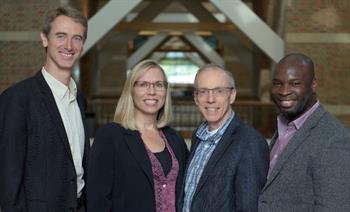
Founders of Autonomic Materials Inc. at the Beckman Institute, where the interdisciplinary collaboration began.
From left: Paul Braun and Nancy Sottos, materials science and engineering; Jeff Moore, chemistry; and Gerald Wilson, AMI CEO and president.
|
Our team was motivated to take our initial concept to the next level, and we founded Autonomic Materials Inc. in 2005, with the mission to design, manufacture and market performance-enhancing technologies that provide self-healing functionality. Our products have a range of applications, including alternative energy, industrial maintenance and machinery, military equipment, infrastructure, oil and gas machinery, transportation, and consumer paints.
The commercial activities of the company began in late 2007 located in a business incubator facility in Champaign, Illinois. In 2012, operations were moved to an independent facility to support the growing staff and the commercialization of their products. “When we started the company, coatings were identified as the first market to go after,” said Gerald Wilson, a co-founder of AMI and the current president and CEO. “There had been a lot of interest expressed from the paint and coating formulators around the concept of self-healing. Basically, we hit the ground running with a good set of potential customers and contacts.”
AMI introduced its first commercial product in 2016; a self-healing epoxy primer named metaPrime marketed by the Illinois-based company Rust-Oleum. General industrial coatings are a $23 billion market. These protective coatings are compromised by abrasion, wear and crack damage when applied in harsh environments and conditions. Rust-Oleum META Prime addresses this issue by offering a self-healing primer to extend coating life for longer-term asset protection.
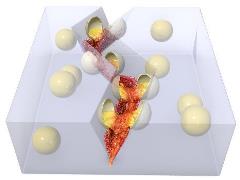
Schematic illustrating the self-healing process of coating containing microcapsules.
|
The type of healing agent used in the microcapsules may be epoxy-based, alkane-based, or silicone-based. The microcapsules are delivered in either a dry form, which can be used in powder coatings, or wet, which is used in water-borne coatings. The microcapsules can be used as adhesives, industrial coatings, wood and concrete coatings, and automotive undercoating, and the microcapsules can improve the longevity of the coatings up to five times, depending on the applications.
“If you use an epoxy coating formulation on a shipping container, for example, the coating remains inactive until that container gets impacted or scratched. When that happens, the capsules break open and release the core materials that are polymer precursors. These polymerize at the site of damage,” Wilson said. “When you increase the performance of a coating that’s used for the protection of expensive assets that are costly to take offline, there are two levels of savings: labor and material costs,” Wilson said. “The coating would be 20% to 25% more expensive, but you could drop one or two maintenance cycles over the lifetime of the asset.”
“For example, in a water tank, the paint is the lowest cost by far. Sending someone with a scaffold to scrape the old paint off, clean the tank, and put new paint on is a lot more expensive. The higher the value of the asset, that’s where you see the real value,” Braun said.
The company is currently interested in working on pretreatment coatings for steel. These formulations usually provide corrosion resistance.
“The focus of AMI is currently on coatings,” Braun said. “We are aware of areas in biomedical devices, aerospace, and restoring strength to materials. We have done some work on these and in five years, we may have a new set of technologies that could work in any one of these areas. It will depend on the market and the customer.”
Note: Scott White, an internationally recognized pioneer in developing self-healing coatings, died May 28, 2018 at age 55. He was a co-founder of AMI, a professor of aerospace engineering at the University of Illinois, and co-leader of the Autonomous Materials Systems Group at the Beckman Institute.
Feedback
You are receiving this newsletter as a subscriber to
Advocacy, or because of your participation in our
Materials Voice letter-writing campaigns. We welcome your feedback and invite you to submit topics for consideration in future issues of this newsletter. A complete PDF version is available at
www.mrs.org/INTERSECTIONS.
If you have or know of stories that illustrate how an investment in materials research paid off in real dollar terms, please send your suggestions to
INTERSECTIONS Editor, Len Brillson, at
[email protected]. Please send your
comments here.
Not a current MRS Member? It’s never too late to
join or renew. Plus, MRS Membership is included in registration for MRS Meetings.
Sign up for newsletters and alerts by visiting
www.mrs.org/alerts, or become a registered user and be sure to select Advocacy to continue receiving this quarterly newsletter.